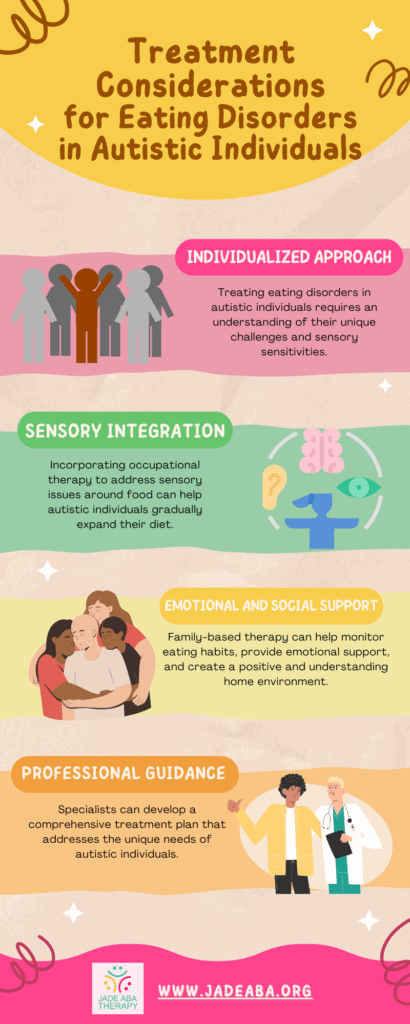Autism Spectrum Disorder (ASD) and eating disorders are complex conditions that often intersect in unique and challenging ways. For parents and caregivers of autistic individuals, understanding this relationship is crucial for effective support and intervention. This article aims to provide an informative overview of why autistic individuals are at higher risk for developing eating disorders and how to address these issues effectively.

Why Are People with Autism at High Risk for Eating Disorders?
Autistic individuals face a unique set of challenges that increase their risk of developing eating disorders. These challenges can include emotional regulation difficulties, sensory sensitivities, and societal pressures, among others. Understanding the specific factors that contribute to this heightened risk can help caregivers provide better support and intervention.
1. Emotional Regulation Issues
Autistic individuals often face difficulties with emotional regulation, which can lead to mental health issues such as anxiety and depression. These emotional struggles can sometimes manifest as eating disorders. Food can become a coping mechanism, providing a sense of control or comfort in overwhelming situations. High-fat and high-sugar foods, in particular, can stimulate neurotransmitters that create a calming effect, making emotional eating a frequent issue.
2. Sensory and Food Preferences
Autistic children often exhibit restrictive eating patterns due to sensory sensitivities, food allergies, or specific texture and taste preferences. These restrictive behaviors can persist into adulthood, contributing to disordered eating patterns. For example, some autistic individuals may only eat foods of certain colors or avoid certain textures, which can severely limit their diet and lead to nutritional deficiencies.
3. Peer Pressure and Social Acceptance
Autistic individuals, especially girls, may feel pressure to conform to societal standards of appearance to fit in with their peers. This pressure can lead to an obsession with weight and body image, resulting in eating disorders such as anorexia or bulimia. The desire to be socially accepted can drive unhealthy eating behaviors and exacerbate existing emotional struggles.
4. Obsessive Interests
Autism is characterized by intense focus on specific interests, which can sometimes include food and eating habits. An autistic individual might become obsessed with calorie counting or strict dietary rules, leading to restrictive eating behaviors. This obsessive focus can quickly escalate into a full-blown eating disorder.
5. Rigid Routines and Thinking
Many autistic individuals have rigid thinking patterns and struggle with cognitive flexibility. This rigidity can manifest in their eating habits, where they might adhere strictly to certain eating routines or diets. The inability to adapt to new ways of eating can intensify disordered eating behaviors and make it difficult to break free from these harmful patterns.

Types of Eating Disorders Common in Autistic Individuals
Autistic individuals may experience eating disorders differently than the general population due to sensory sensitivities, rigid routines, and heightened anxiety. Eating disorders manifest in various ways, each presenting unique challenges and health risks. Here’s an in-depth look at the eating disorders frequently observed in autistic individuals:
Anorexia Nervosa
Anorexia nervosa is characterized by an intense fear of gaining weight and a distorted body image, leading to severe food restriction and excessive weight loss. The condition can lead to severe malnutrition, bone thinning, heart issues, and even cognitive decline. Autistic individuals with anorexia might fixate on the control and predictability of their eating habits, using restriction as a means to manage anxiety.
Bulimia Nervosa
Bulimia involves cycles of binge eating followed by purging through vomiting, laxatives, or excessive exercise. This disorder can cause severe physical health issues, including dental problems, gastrointestinal distress, and heart complications.
Binge-Eating Disorder
Binge-eating disorder is marked by recurrent episodes of eating large amounts of food, often quickly and to the point of discomfort, without subsequent purging behaviors. This disorder can lead to obesity, diabetes, and cardiovascular issues. For autistic individuals, binge eating can be a response to stress, sensory overload, or a way to self-soothe.
Pica
Pica involves the persistent ingestion of non-nutritive substances such as hair, dirt, or paper. It is more common in autistic individuals, particularly those with sensory processing issues or intellectual disabilities. Pica can lead to serious health complications, including gastrointestinal blockages, poisoning, and nutritional deficiencies.
Avoidant/Restrictive Food Intake Disorder (ARFID)
ARFID is characterized by extreme picky eating or general avoidance of food, which can lead to significant weight loss, nutritional deficiencies, and dependence on nutritional supplements or feeding tubes. Unlike anorexia, ARFID is not driven by body image concerns but rather by sensory and anxiety-related issues. Autistic individuals with ARFID might avoid certain foods due to sensory sensitivities or fears related to choking or vomiting.
Other Specified Feeding and Eating Disorders
Autistic individuals might exhibit disordered eating patterns that blend features of different disorders, such as a combination of restrictive eating and occasional bingeing. This disorder category includes eating disorders that do not fully match the criteria of the other specified disorders but still cause significant distress and impairment.

Treatment Considerations
Treating eating disorders in autistic individuals requires a nuanced approach that considers their unique sensory, cognitive, and emotional challenges. Traditional treatment methods might not always be effective, so it’s essential to adapt strategies to meet the specific needs of autistic patients.
Individualized Approach
Treating eating disorders in autistic individuals requires an understanding of their unique challenges and sensory sensitivities. Therapy should be tailored to address both the eating disorder and the underlying autism traits.
Sensory Integration
Incorporating occupational therapy to address sensory issues around food can help autistic individuals gradually expand their diet. Introducing new foods slowly and in a non-stressful environment can make a significant difference.
Emotional and Social Support
Building a strong support system that includes family involvement is crucial. Family-based therapy can help monitor eating habits, provide emotional support, and create a positive and understanding home environment.
Professional Guidance
Seeking help from professionals who have experience with both autism and eating disorders is vital. These specialists can develop a comprehensive treatment plan that addresses the unique needs of autistic individuals.
The Takeaway
Autistic individuals are at a higher risk for developing eating disorders due to a combination of emotional regulation issues, sensory sensitivities, social pressures, obsessive interests, and rigid routines. Understanding these factors can help parents and caregivers provide the necessary support and seek appropriate treatment.
A tailored, compassionate approach that considers the unique challenges of autism can significantly improve the outcomes for individuals struggling with eating disorders. And, by staying informed and proactive, parents and caregivers can play a crucial role in helping their loved ones navigate the complex intersection of autism and eating disorders.
Sources: